Joint Optimal Scheduling of Power Grid and Internet Data Centers Considering Time-of-Use Electricity Price and Adjustable Tasks for Renewable Power Integration
Abstract
1. Introduction
2. IDC-Power Grid Joint Scheduling Model
2.1. Two-Layer Optimization Model of IDC-Power Grid
2.2. IDC-Power System Model
2.2.1. Power System Model
2.2.2. IDC Model
2.2.3. Joint Scheduling Model Objective Function
2.2.4. Joint Scheduling Model Operating Constraints
2.3. Solution of the Electricity Price Elasticity Coefficient Matrix of the IDC
3. Distributed Solving Method
3.1. Enhanced Benders Decomposition
3.2. Distributed Solution Process
3.3. Discussion
4. Case Analysis
System Case and Analysis
5. Conclusions
- (1)
- The IDC-power grid bi-level optimization model proposed in this paper can effectively express the collaborative optimization relationship between the two entities, achieving optimized planning while ensuring reasonable economic benefits for both systems. Compared with individual optimization, the proposed optimization model can reduce the operational costs of IDC and power grid systems by 7.356%.
- (2)
- The time-of-use electricity price can guide IDC to adjust computing task scheduling strategies. With the adjustable characteristics of computing tasks, the IDC can participate in demand-side response. This mechanism facilitates peak shaving and valley filling in power systems while enhancing renewable energy integration.
- (3)
- A 39-node distribution system is selected as a simulation case, and the solution effects of the method proposed in this paper and conventional methods are compared. The simulation results prove the effectiveness and good convergence of the proposed method.
Author Contributions
Funding
Institutional Review Board Statement
Informed Consent Statement
Data Availability Statement
Conflicts of Interest
Notations
| A, B, C, D, E, F, H, I, J, K, L, M | Constant coefficient matrix |
| a, b, c, d, e, f, g, h | Constant coefficient |
| C | Economics cost |
| E, e | Elasticity coefficient matrix, elasticity coefficient |
| I | Operational status decision variables |
| P | Active powers |
| T | Working hours of IDC tasks |
| x, y, m, z, u | Variables |
| λ | Linearized generators output cost of IDC |
References
- Ruan, J.; Zhu, Y.; Cao, Y.; Sun, X.; Lei, S.; Liang, G. Privacy-preserving bi-level optimization of internet data centers for electricity-carbon joint demand response. IEEE Internet Things J. 2024, 11, 24948–24959. [Google Scholar] [CrossRef]
- Liu, J.; Xu, Z.; Wu, J.; Liu, K.; Sun, X.; Guan, X. Optimal planning of internet data centers decarbonized by hydrogen-water-based energy systems. IEEE Trans. Autom. Sci. Eng. 2023, 20, 1577–1590. [Google Scholar] [CrossRef]
- Yuan, H.; Bi, J.; Zhou, M. Geography-aware task scheduling for profit maximization in distributed green data centers. IEEE Trans. Cloud Comput. 2022, 10, 1864–1874. [Google Scholar] [CrossRef]
- Qi, W.; Li, J.; Liu, Y.; Liu, C. Planning of distributed internet data center microgrids. IEEE Trans. Smart Grid 2019, 10, 762–771. [Google Scholar] [CrossRef]
- Chen, M.; Gao, C.; Li, Z.; Shahidehpour, M.; Zhou, Q.; Chen, S. Aggregated model of data network for the provision of demand response in generation and transmission expansion planning. IEEE Trans. Smart Grid 2021, 12, 512–523. [Google Scholar] [CrossRef]
- Han, O.; Ding, T.; Mu, C.; Jia, W.; Ma, Z. Coordinative optimization between multiple data center operators and a system operator based on two-level distributed scheduling algorithm. IEEE Internet Things J. 2023, 10, 7517–7527. [Google Scholar] [CrossRef]
- Chen, S.; Li, J.; Yuan, Q.; He, H.; Li, S.; Yang, J. Two-timescale joint optimization of task scheduling and resource scaling in multi-data center system based on multi-agent deep reinforcement learning. IEEE Trans. Parallel Distrib. Syst. 2024, 35, 2331–2346. [Google Scholar] [CrossRef]
- Yuan, H.; Bi, J.; Zhou, M. Spatiotemporal task scheduling for heterogeneous delay-tolerant applications in distributed green data centers. IEEE Trans. Autom. Sci. Eng. 2019, 16, 1686–1697. [Google Scholar] [CrossRef]
- Liang, B.; Bai, J. Low-energy resource classification algorithm for cross-regional cloud data centers based on k-means clustering algorithm. IEEE Trans. Ind. Inform. 2024, 20, 10084–10091. [Google Scholar] [CrossRef]
- Chiu, W.; Hsieh, W.; Chen, C.; Chuang, Y. Multiobjective demand response for internet data centers. IEEE Trans. Emerg. Top. Comput. Intell. 2022, 6, 365–376. [Google Scholar] [CrossRef]
- Wu, Z.; Chen, L.; Wang, J.; Zhou, M.; Li, G.; Xia, Q. Incentivizing the spatiotemporal flexibility of data centers toward power system coordination. IEEE Trans. Netw. Sci. Eng. 2023, 10, 1766–1778. [Google Scholar] [CrossRef]
- Chhabra, S.; Singh, A. Dynamic resource allocation method for load balance scheduling over cloud data center networks. J. Web Eng. 2021, 20, 2269–2284. [Google Scholar] [CrossRef]
- Mukherjee, D.; Ghosh, S.; Pal, S.; Aly, A.; Le, D. Adaptive scheduling algorithm based task loading in cloud data centers. IEEE Access 2022, 10, 49412–49421. [Google Scholar] [CrossRef]
- Xiong, Y.; Huang, S.; Wu, M.; She, J.; Jiang, K. A Johnson’s-rule-based genetic algorithm for two-stage-task scheduling problem in data-centers of cloud computing. IEEE Trans. Cloud Comput. 2019, 7, 597–610. [Google Scholar] [CrossRef]
- Chen, M.; Gao, C.; Shahidehpour, M.; Li, Z.; Chen, S.; Li, D. Internet data center load modeling for demand response considering the coupling of multiple regulation methods. IEEE Trans. Smart Grid 2021, 12, 2060–2076. [Google Scholar] [CrossRef]
- Yuan, H.; Bi, J.; Zhou, M.; Liu, Q.; Ammari, A. Biobjective task scheduling for distributed green data centers. IEEE Trans. Autom. Sci. Eng. 2021, 18, 731–742. [Google Scholar] [CrossRef]
- Xu, J.; Feng, P.; Gong, J.; Li, S.; Jiang, G.; Yang, H. Low-Voltage Ride-Through Strategy to Doubly-Fed Induction Generator with Passive Sliding Mode Control to the Rotor-Side Converter. Energies 2024, 17, 4439. [Google Scholar] [CrossRef]
- Wang, B.; Wang, L.; Ma, Y.; Hou, D.; Sun, W.; Li, S. A Short-Term Load Forecasting Method Considering Multiple Factors Based on VAR and CEEMDAN-CNN-BILSTM. Energies 2025, 18, 1855. [Google Scholar] [CrossRef]
- Wu, X.; You, L.; Wu, R.; Zhang, Q.; Liang, K. Management and control of load clusters for ancillary services using internet of electric loads based on cloud-edge-end distributed computing. IEEE Internet Things J. 2022, 9, 18267–18279. [Google Scholar] [CrossRef]
- Wang, P.; Cao, Y.; Ding, Z. Flexible multi-energy scheduling scheme for data center to facilitate wind power integration. IEEE Access 2020, 8, 88876–88891. [Google Scholar] [CrossRef]
- Zhang, Q.; Jiang, Y.; Ge, X.; Huang, Y.; Liu, Y. Distributed data flow scheduling optimization in industrial internet of things based on optimal transport theory. IEEE Internet Things J. 2023, 10, 12961–12974. [Google Scholar] [CrossRef]
- Liu, L.; Shen, X.; Chen, Z.; Sun, Q.; Wennersten, R. Optimal energy management of data center micro-grid considering computing workloads shift. IEEE Access 2024, 12, 102061–102075. [Google Scholar] [CrossRef]
- Ye, G.; Gao, F. Coordinated optimization scheduling of data center and electricity retailer based on cooperative game theory. CPSS Trans. Power Electron. Appl. 2022, 7, 273–282. [Google Scholar] [CrossRef]
- Li, Z.; Shahidehpour, M. Privacy-preserving joint operation of networked microgrids with the local utility grid based on enhanced benders decomposition. IEEE Trans. Smart Grid 2020, 11, 2638–2651. [Google Scholar] [CrossRef]
- Li, S.; Ye, J. Analytical evaluation to power system oscillation damping capability of DFIG-POD based on path damping torque analysis. IEEE Trans. Sustain. Energy 2025, 16, 496–511. [Google Scholar] [CrossRef]
- Feng, P.; Xu, J.; Wang, Z.; Li, S.; Shen, Y.; Gui, X. Impact of phase angle jump on a doubly fed induction generator under low-voltage ride-through based on transfer function decomposition. Energies 2024, 17, 4778. [Google Scholar] [CrossRef]
- Li, S.; Li, Y. Suppression to commutation failure of UHVDC in hierarchical connection mode with synchronous condenser by enhancing post-fault system strength. IEEE Trans. Power Deliv. 2025, 40, 864–877. [Google Scholar] [CrossRef]
- Li, S.; Tao, D. Dynamic equivalence to heterogeneous wind farm while preserving interaction among DFIGs based on interactive currents and their sensitivities. IEEE Trans. Power Syst. 2025, 1–16. [Google Scholar] [CrossRef]
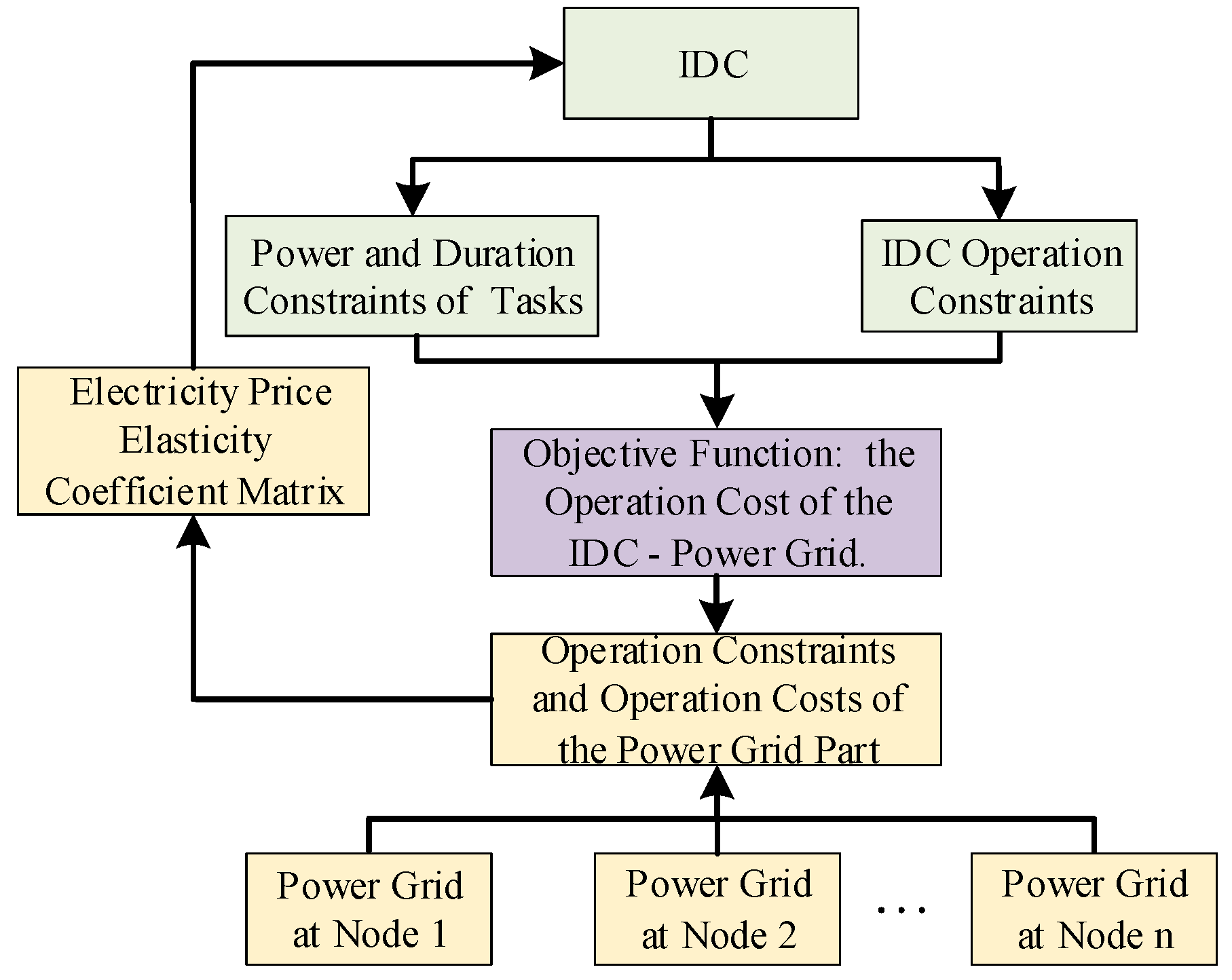

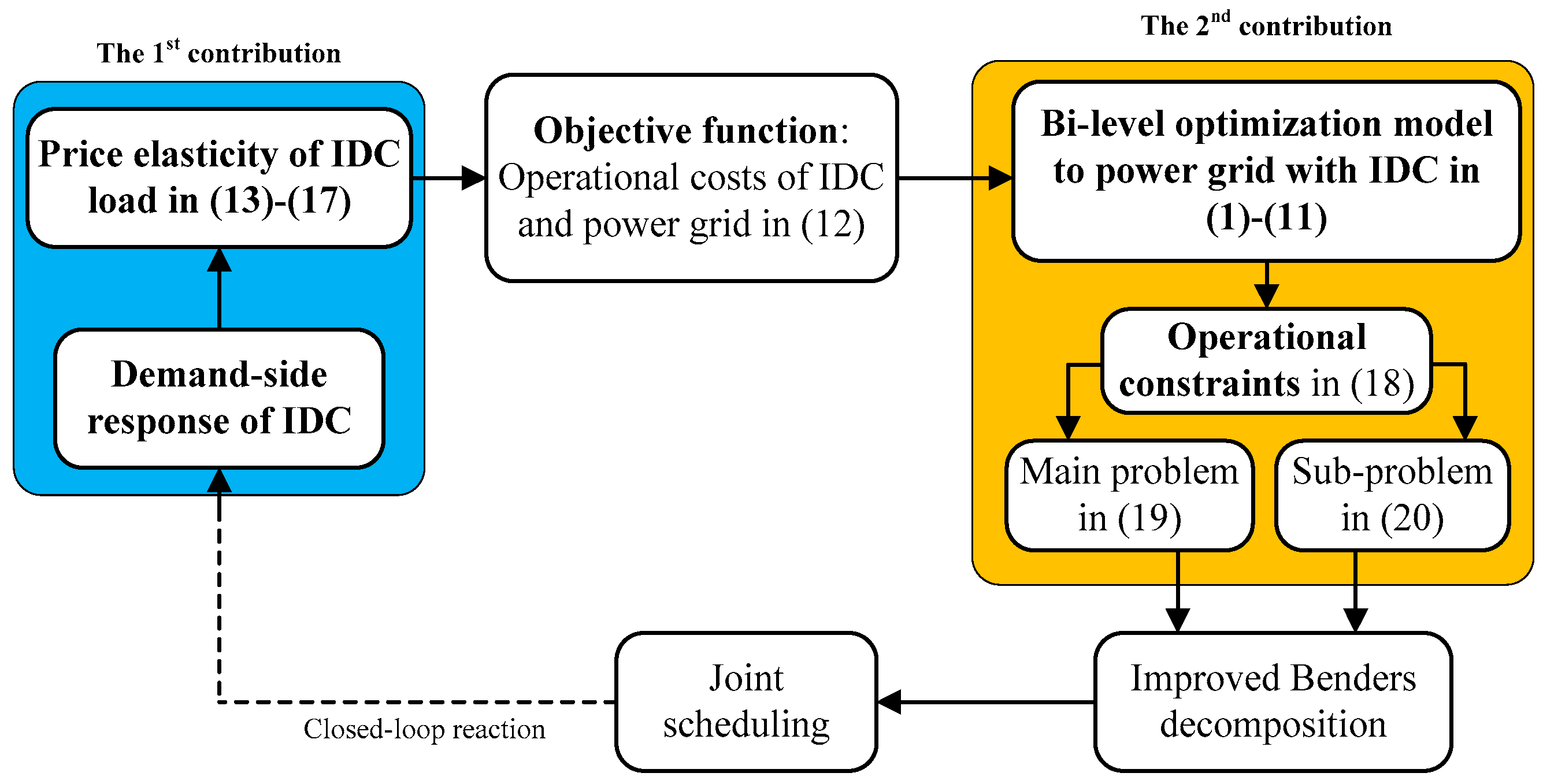


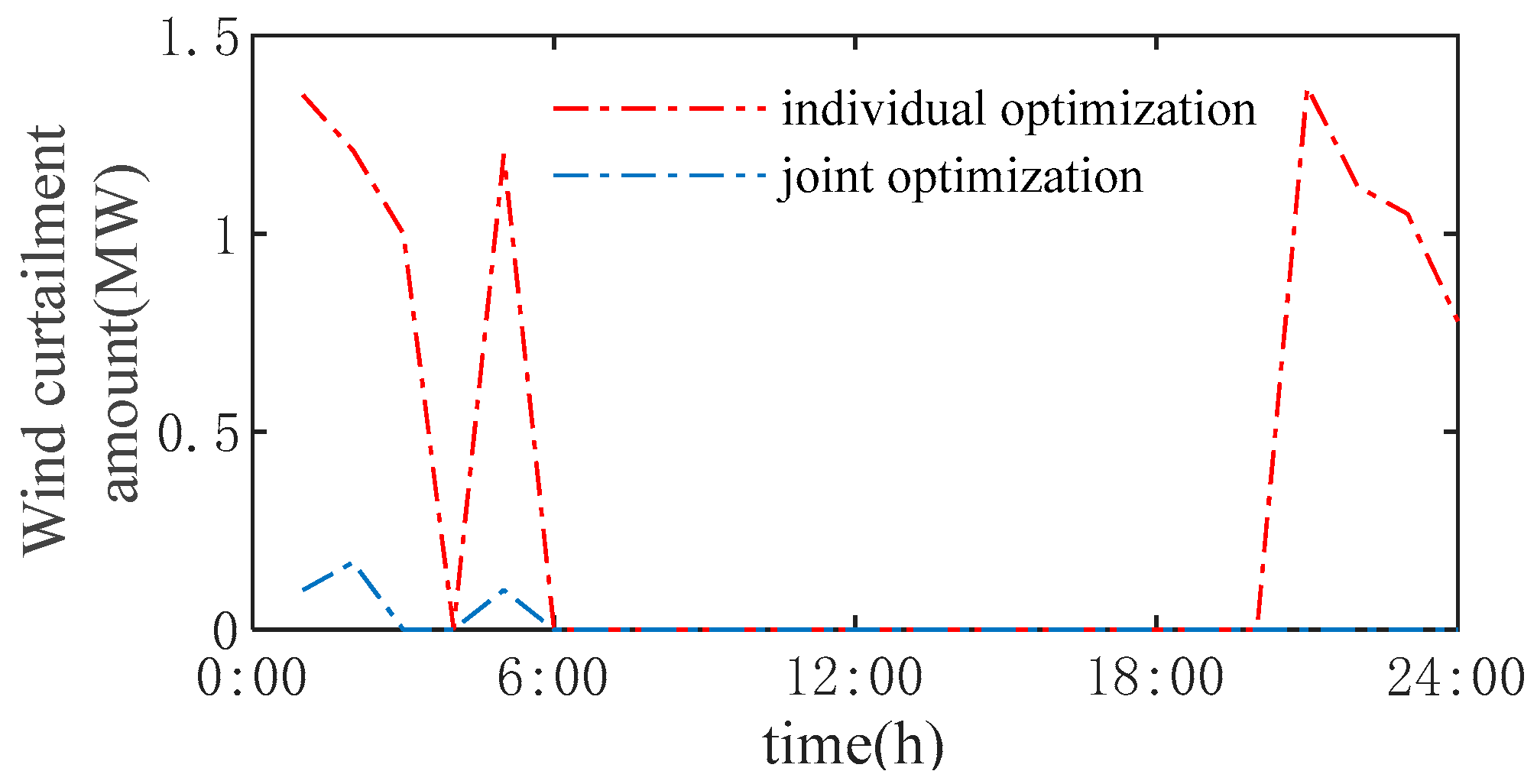

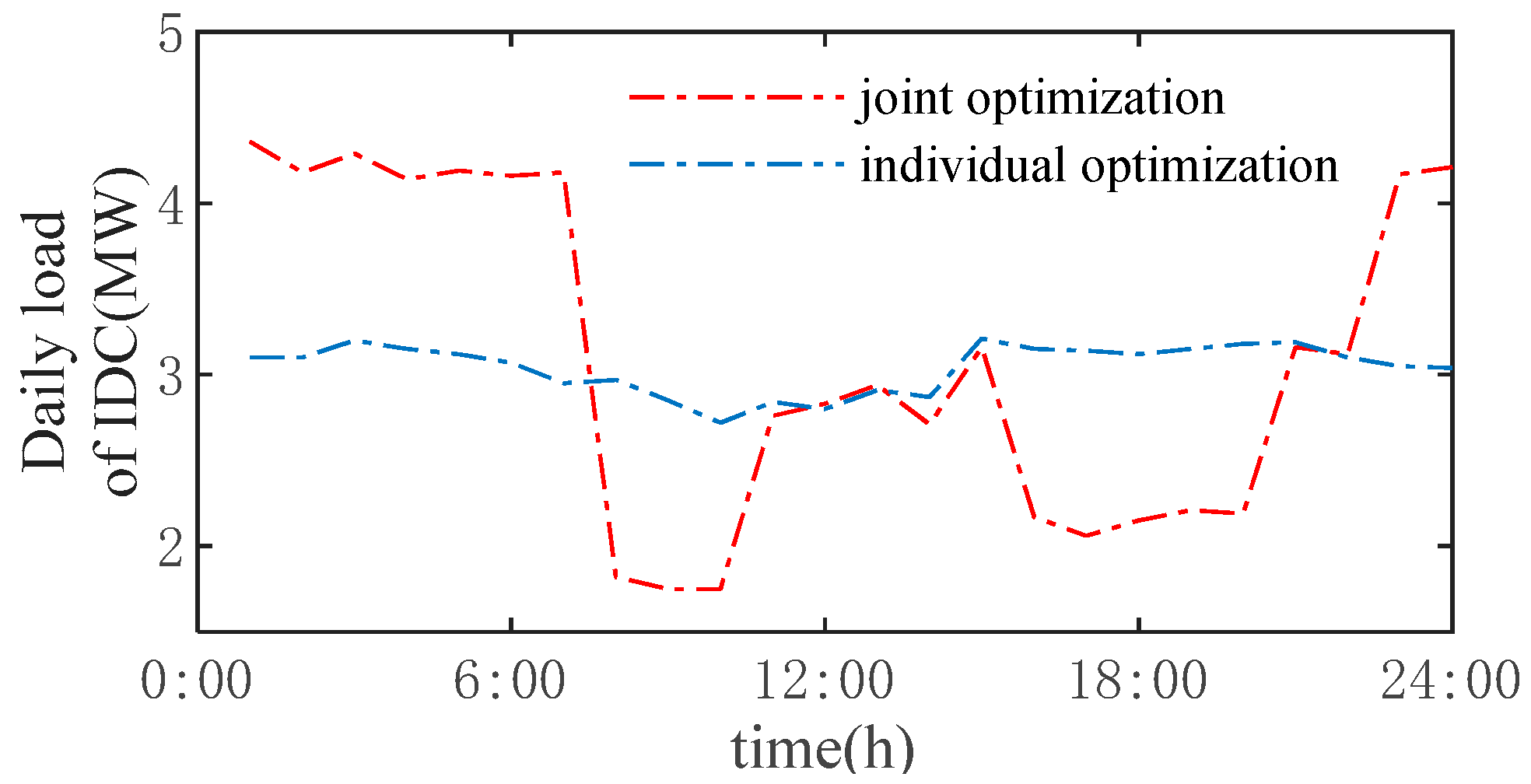


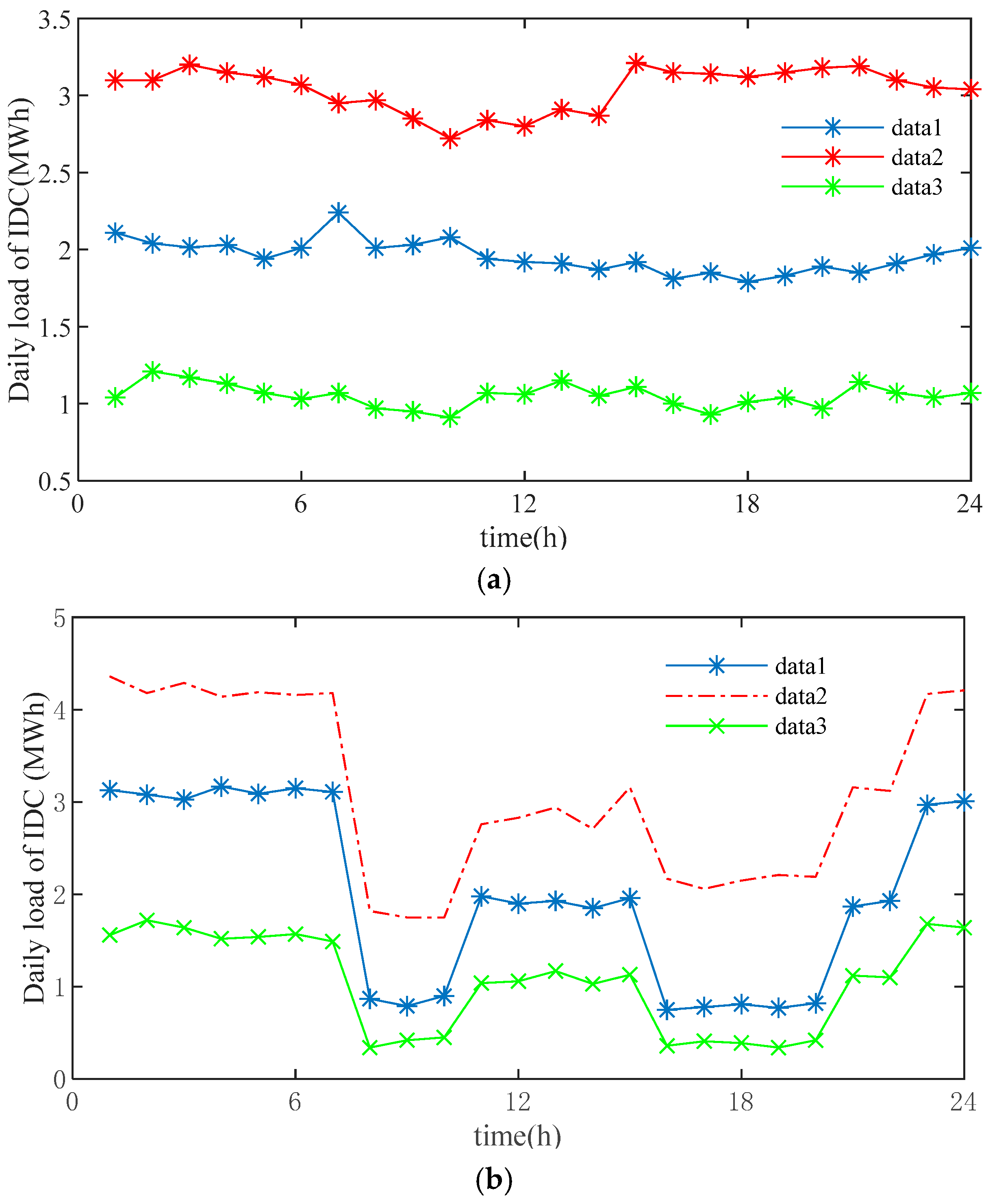
| Assignment Type | Characteristic | Before | After | Assignment Number |
|---|---|---|---|---|
| reducible tasks | average power | pk | [m1 + 1, m2] | |
| transferable tasks | startup time | tk | [m2 + 1, m3] | |
| shiftable tasks | startup time | tk | … | [m3 + 1, m4] |
| Cost/$ | Individual Optimization [B1–B2] | Branch and Bound [B3–B5] | Joint Optimization in This Paper |
|---|---|---|---|
| operation cost of power grid | 11,389.66 | 11,078.46 ↓ | 10,965.94 ↓ |
| operation cost of IDC | 5888.25 | 5518.71 ↓ | 5040.95 ↓ |
| total cost | 17,277.91 | 16,597.17 ↓ | 16,006.89 ↓ |
| Type | Iteration | Time (s) |
|---|---|---|
| Centralized algorithm | 1 | 0.05 |
| Benders | 112 | 0.62 |
Disclaimer/Publisher’s Note: The statements, opinions and data contained in all publications are solely those of the individual author(s) and contributor(s) and not of MDPI and/or the editor(s). MDPI and/or the editor(s) disclaim responsibility for any injury to people or property resulting from any ideas, methods, instructions or products referred to in the content. |
© 2025 by the authors. Licensee MDPI, Basel, Switzerland. This article is an open access article distributed under the terms and conditions of the Creative Commons Attribution (CC BY) license (https://creativecommons.org/licenses/by/4.0/).
Share and Cite
Hou, D.; Wang, L.; Ma, Y.; Lyu, L.; Liu, W.; Li, S. Joint Optimal Scheduling of Power Grid and Internet Data Centers Considering Time-of-Use Electricity Price and Adjustable Tasks for Renewable Power Integration. Sustainability 2025, 17, 3374. https://doi.org/10.3390/su17083374
Hou D, Wang L, Ma Y, Lyu L, Liu W, Li S. Joint Optimal Scheduling of Power Grid and Internet Data Centers Considering Time-of-Use Electricity Price and Adjustable Tasks for Renewable Power Integration. Sustainability. 2025; 17(8):3374. https://doi.org/10.3390/su17083374
Chicago/Turabian StyleHou, Dengshan, Li Wang, Yanru Ma, Longbiao Lyu, Weijie Liu, and Shenghu Li. 2025. "Joint Optimal Scheduling of Power Grid and Internet Data Centers Considering Time-of-Use Electricity Price and Adjustable Tasks for Renewable Power Integration" Sustainability 17, no. 8: 3374. https://doi.org/10.3390/su17083374
APA StyleHou, D., Wang, L., Ma, Y., Lyu, L., Liu, W., & Li, S. (2025). Joint Optimal Scheduling of Power Grid and Internet Data Centers Considering Time-of-Use Electricity Price and Adjustable Tasks for Renewable Power Integration. Sustainability, 17(8), 3374. https://doi.org/10.3390/su17083374





